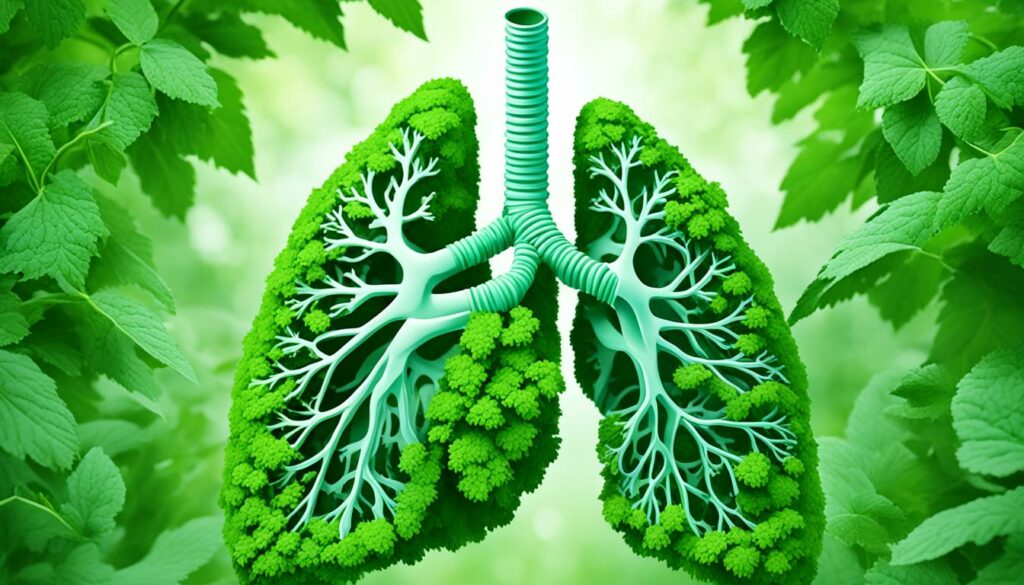Have you ever wondered how athletes improve their performance at high altitudes? What if there was a way to boost endurance, enhance oxygen consumption, and increase red blood cell production? Well, it turns out that pre-acclimatization altitude training offers these incredible benefits and more!
Key Takeaways:
- Pre-acclimatization altitude training improves athletic performance at high altitudes.
- Altitude training boosts endurance and enhances oxygen consumption.
- It increases red blood cell production and improves aerobic capacity.
- Altitude training enhances lung function and reduces symptoms of altitude sickness.
- These benefits make pre-acclimatization altitude training a game-changer for athletes seeking to perform at their best in high-altitude environments.
How Altitude Training Works
Altitude training, whether through exposure to real or simulated altitude, elicits various physiological responses in the body to counteract the effects of hypoxia. These responses play a crucial role in enhancing athletic performance and overall adaptation to high-altitude environments.
Hypoxic Ventilatory Response
One of the primary physiological responses to hypoxia during altitude training is an increase in ventilation, known as the hypoxic ventilatory response. This mechanism is responsible for the elevated breathing rate and depth observed at high altitudes, facilitating the intake of a higher volume of air and maximizing oxygen availability to the body’s tissues.
Hemoconcentration and Sympathetic Activation
Altitude training also triggers hemoconcentration, the reduction in blood plasma volume due to increased diuresis. This process optimizes the concentration of red blood cells and enhances oxygen-carrying capacity. Additionally, sympathetic activation leads to elevated heart rate and cardiac output, promoting efficient oxygen delivery to muscles and organs.
Changes in Cerebral Blood Flow and Pulmonary Vasoconstriction
During altitude training, cerebral blood flow undergoes significant changes to adapt to the reduced oxygen availability. The body responds by constricting blood vessels in the brain, a phenomenon known as hypoxia pulmonary vasoconstriction. This redirection of blood flow helps maintain an optimal balance between oxygen supply and demand in vital organs.
Erythropoietin Production and Angiogenesis
Altitude training stimulates the production of erythropoietin, a hormone responsible for red blood cell production. This increase in erythropoietin levels promotes the formation of new red blood cells, enhancing oxygen transport and improving endurance capacity. Additionally, altitude training induces angiogenesis, the growth of new blood vessels, further optimizing oxygen delivery to muscles and tissues.
Mitochondrial Energy Metabolism
Altitude training induces adaptations in mitochondrial energy metabolism, enhancing the efficiency of oxygen utilization within cells. These adaptations optimize aerobic metabolism, allowing athletes to sustain high levels of energy production and endurance performance for prolonged periods.
Overall, altitude training elicits a myriad of physiological responses, including the hypoxic ventilatory response, hemoconcentration, sympathetic activation, changes in cerebral blood flow, hypoxia pulmonary vasoconstriction, erythropoietin production, adaptations in mitochondrial energy metabolism, and angiogenesis. These responses collectively enhance an athlete’s ability to thrive in high-altitude environments and improve their overall performance.
| Physiological Responses to Altitude Training | Effects |
|---|---|
| Hypoxic Ventilatory Response | Increased ventilation for improved oxygen intake |
| Hemoconcentration | Optimized red blood cell concentration for enhanced oxygen-carrying capacity |
| Sympathetic Activation | Elevated heart rate and cardiac output for efficient oxygen delivery |
| Changes in Cerebral Blood Flow | Adaptation to reduced oxygen availability in the brain |
| Hypoxia Pulmonary Vasoconstriction | Constriction of blood vessels in the lungs to balance oxygen supply and demand |
| Erythropoietin Production | Stimulated red blood cell production for improved endurance capacity |
| Mitochondrial Energy Metabolism | Enhanced efficiency of oxygen utilization within cells |
| Angiogenesis | Growth of new blood vessels for optimized oxygen delivery |
Improved Oxygen Delivery and Aerobic Capacity
One of the key benefits of pre-acclimatization altitude training is the improvement in oxygen delivery to the tissues, leading to enhanced aerobic capacity. Altitude training brings about several physiological changes that optimize the body’s ability to utilize oxygen efficiently and improve overall endurance performance.
Oxygen Delivery
During altitude training, the body adapts to the reduced availability of oxygen by increasing arterial partial pressure of oxygen (PaO2) and arterial oxygen saturation (SaO2). These modifications result in a more efficient oxygen-carrying capacity of the blood, allowing for greater oxygen supply to active muscles.
Respiratory Adaptations
Altitude training also induces respiratory adaptations, such as a decrease in arterial partial pressure of carbon dioxide (PaCO2), leading to respiratory alkalosis. This alkalosis stimulates the renal excretion of bicarbonate, optimizing the body’s acid-base balance and further enhancing the delivery of oxygen to the tissues.
Physiological Adaptations in Improved Oxygen Delivery
| Physiological Adaptations | Effect |
|---|---|
| Increase in arterial partial pressure of oxygen (PaO2) | Enhanced oxygen supply to active muscles |
| Higher arterial oxygen saturation (SaO2) | Improved oxygen-carrying capacity of the blood |
| Decrease in arterial partial pressure of carbon dioxide (PaCO2) | Stimulation of respiratory alkalosis |
| Renal excretion of bicarbonate | Optimization of acid-base balance and oxygen delivery |
These adaptations in oxygen delivery contribute to an increased aerobic capacity, allowing athletes to sustain higher levels of exertion for longer periods. By training at altitude, athletes can enhance their performance and endurance capabilities by capitalizing on the body’s response to hypoxic conditions.
Increased Red Blood Cell Production and Oxygen Transport
Pre-acclimatization altitude training plays a crucial role in enhancing red blood cell production, a process known as erythropoiesis. This physiological adaptation is triggered by the upregulation of erythropoietin (EPO) and vascular endothelial growth factor (VEGF), both of which stimulate the production of red blood cells in the body. As a result, the increased red blood cell count improves oxygen transport, allowing for optimal aerobic metabolism and endurance performance.
Furthermore, altitude training also promotes the formation of new capillaries, a process called angiogenesis. This development of capillary networks enhances oxygen delivery to the body’s tissues, particularly in the skeletal muscles. The improved capillarity ensures that oxygen is efficiently transported to the working muscles, further optimizing endurance performance.
The Role of Erythropoietin and Vascular Endothelial Growth Factor
Erythropoietin (EPO) is a hormone produced primarily by the kidneys in response to low oxygen levels in the body. When exposed to high altitudes during pre-acclimatization training, the body recognizes the need for increased red blood cell production to enhance oxygen-carrying capacity. Consequently, EPO levels rise, stimulating the bone marrow to produce more red blood cells.
Vascular endothelial growth factor (VEGF) is a key player in promoting angiogenesis, the growth of new blood vessels. During altitude training, VEGF is upregulated, leading to the formation of new capillaries. These newly formed capillaries increase the surface area for oxygen exchange and improve oxygen delivery to the tissues.
The Impact on Oxygen Transport and Endurance Performance
The increase in red blood cell production and the promotion of angiogenesis have significant implications for oxygen transport and endurance performance. With a higher number of red blood cells, the body can transport more oxygen to the working muscles, allowing for improved aerobic metabolism and energy production.
Additionally, the enhanced capillarity resulting from altitude training ensures that oxygen is efficiently delivered to the tissues, improving the oxygen extraction process. This optimized oxygen transport and utilization contribute to improved endurance performance, enabling athletes to sustain physical exertion for longer periods.
Enhanced Lung Function and Oxygen Utilization
Pre-acclimatization altitude training plays a vital role in enhancing lung function and optimizing oxygen utilization in the body. This section explores how altitude training improves pulmonary vasoconstriction, pulmonary arterial pressure, and the alveolar oxygen and carbon dioxide partial pressures. These adaptations lead to respiratory alkalosis, which ultimately enhances endurance performance.
Improved Pulmonary Vasoconstriction
Altitude training improves pulmonary vasoconstriction, a mechanism that helps regulate blood flow in the lungs. By enhancing this process, the body is better able to direct blood flow to areas with optimal oxygenation, improving overall lung function. This optimization allows for increased uptake and delivery of oxygen to the body’s tissues, improving athletic performance at high altitudes.
Reduced Pulmonary Arterial Pressure
A key benefit of pre-acclimatization altitude training is the reduction in pulmonary arterial pressure. As individuals adapt to the hypoxic environment, the pulmonary artery constricts, resulting in decreased pressure and workload on the right side of the heart. This adaptation improves the efficiency of oxygen transport and reduces the strain on the cardiovascular system during exercise at high altitudes.
Optimized Alveolar Oxygen and Carbon Dioxide Partial Pressures
Altitude training also leads to improved alveolar oxygen and carbon dioxide partial pressures. With exposure to hypoxia, the alveoli in the lungs undergo adaptations that optimize gas exchange. This results in increased oxygen uptake and improved removal of carbon dioxide, facilitating better respiratory function and oxygen utilization in the body.
“Altitude training enhances lung function, optimizing oxygen uptake and utilization, leading to improved endurance performance.”
| Lung Function Adaptations | Benefits |
|---|---|
| Pulmonary Vasoconstriction | Improved blood flow regulation in the lungs |
| Pulmonary Arterial Pressure Reduction | Decreased strain on the cardiovascular system |
| Alveolar Gas Exchange Optimization | Enhanced oxygen uptake and efficient carbon dioxide removal |

The table above summarizes the key adaptations in lung function during pre-acclimatization altitude training and their associated benefits. These improvements ultimately contribute to enhanced endurance performance at high altitudes, allowing athletes to excel in challenging environments.
Reduced Symptoms of Altitude Sickness
Altitude sickness, also known as acute mountain sickness (AMS), can pose significant health risks for individuals traveling to high altitudes. Additionally, high-altitude cerebral edema (HACE) and high-altitude pulmonary edema (HAPE) are severe forms of altitude sickness that require immediate medical attention.
However, pre-acclimatization altitude training can help reduce the symptoms of altitude sickness and minimize the risk of developing these dangerous conditions. By gradually exposing the body to hypoxic conditions, athletes and individuals can adapt more effectively to high altitudes.
The Lake Louise Scoring system, a commonly used assessment tool, aids in diagnosing and monitoring the symptoms of AMS. This scoring system evaluates specific symptoms such as headache, gastrointestinal distress, fatigue, and dizziness, allowing healthcare professionals to assess the severity of altitude sickness.
“Altitude sickness can be a serious concern for individuals traveling to high altitudes. Pre-acclimatization altitude training is an effective method to reduce the risk of developing AMS, HACE, and HAPE, enabling athletes and adventurers to safely explore high-altitude environments.”
By undergoing pre-acclimatization altitude training, individuals can experience reduced symptoms of altitude sickness, enhancing their ability to perform physical activities and enjoy their time at higher elevations. This gradual adaptation process allows the body to acclimate to lower oxygen levels and minimize the physiological stress associated with altitude exposure.
Benefits of Pre-Acclimatization Altitude Training for Reducing Symptoms of Altitude Sickness
- Enhances the body’s ability to cope with reduced oxygen levels
- Reduces the risk of experiencing headaches, dizziness, and fatigue
- Improves overall comfort and well-being at high altitudes
- Minimizes the likelihood of developing severe altitude-related conditions
By incorporating pre-acclimatization altitude training into their preparation routine, individuals can optimize their ability to adapt to high altitudes and mitigate the symptoms of altitude sickness, ensuring a safer and more enjoyable experience.
Applications of Pre-Acclimatization Altitude Training
Pre-acclimatization altitude training offers a wide range of applications that benefit both athletes and individuals seeking to enhance their experiences at high altitudes. By undergoing hypoxic preconditioning, individuals can mitigate the risk of altitude-related illnesses and optimize their overall performance and well-being in high-altitude environments.
“Altitude training has revolutionized the preparation for mountaineering expeditions and elevated the safety and enjoyment of leisurely ski vacations.”
Whether you are a mountaineer embarking on an exhilarating high-altitude expedition or a vacationer looking forward to a leisurely ski vacation, pre-acclimatization altitude training can significantly enhance your experience and safety. Let’s explore the diverse applications of this training method:
1. Preparing for Mountaineering Expeditions
Hiking and climbing at high altitudes can pose several challenges to mountaineers. Acclimatizing to the reduced oxygen levels and harsh environmental conditions is crucial for successful summit attempts. Pre-acclimatization altitude training allows mountaineers to stimulate physiological adaptations to hypoxia, improving their readiness for the high-altitude environment. By enhancing oxygen delivery, aerobic capacity, and lung function, mountaineers can sustain their performance, mitigate the risk of altitude illnesses, and increase their chances of a successful summit.
2. Enjoyable and Safe Ski Vacations
Leisurely ski vacations can be negatively impacted by the adverse effects of high altitudes on individuals who are not acclimatized. Symptoms of altitude sickness such as headache, fatigue, and nausea can put a damper on the vacation experience. Pre-acclimatization altitude training offers an effective solution, enabling individuals to adapt more quickly to high altitudes and reduce the likelihood of experiencing altitude-related illnesses. By improving oxygen utilization and mitigating the effects of hypoxia, individuals can fully enjoy their ski vacations and make lasting memories.
3. Prevention of Altitude Illnesses
Altitude sickness, including conditions such as acute mountain sickness (AMS), high-altitude cerebral edema (HACE), and high-altitude pulmonary edema (HAPE), can be serious and potentially life-threatening. Pre-acclimatization altitude training plays a vital role in reducing both the occurrence and severity of altitude illnesses. By gradually exposing the body to hypoxic conditions, individuals can initiate physiological adaptations that minimize the risk of developing these conditions. This training method can make a significant difference in preventing altitude-related illnesses and ensuring a safe and enjoyable experience in high-altitude environments.
| Applications of Pre-Acclimatization Altitude Training | Benefits |
|---|---|
| Preparing for Mountaineering Expeditions | Enhanced performance, reduced risk of altitude illnesses |
| Enjoyable and Safe Ski Vacations | Improved adaptation to high altitudes, reduced altitude sickness symptoms |
| Prevention of Altitude Illnesses | Minimized occurrence and severity of altitude sickness |
These applications illustrate the wide-ranging benefits of pre-acclimatization altitude training. Whether you are an athlete preparing for a mountaineering expedition or an individual planning a leisurely ski vacation, incorporating this training method into your routine can optimize your performance, enhance your safety, and facilitate a smoother transition to high-altitude environments.
Hypoxico Training for Rapid Ascent Mountaineering
Hypoxico training, in collaboration with organizations like Alpenglow Expeditions, has revolutionized the sport of rapid ascent mountaineering. By using altitude training equipment and pre-acclimatizing from home before embarking on a climbing expedition, mountaineers can significantly reduce their time investment and increase safety.
With Hypoxico training, climbers undergo simulated altitude exposure, which mimics the oxygen levels experienced at high altitudes. This pre-acclimatization process prepares the body for the challenges of rapid ascent mountaineering, minimizing the risk of altitude-related illnesses and improving overall performance.
The benefits of Hypoxico training for rapid ascent mountaineering are threefold. Firstly, it allows climbers to adjust to the lower oxygen levels commonly found at high altitudes. This adjustment period enables mountaineers to perform better and avoid the negative effects of altitude sickness, ensuring a safer and more enjoyable climbing experience.
Secondly, Hypoxico training reduces the time investment required for acclimatization. Instead of spending weeks or even months acclimatizing on the mountain, climbers can accelerate the process beforehand. This allows for shorter expeditions, making it more convenient for climbers with limited time availability.
Lastly, Hypoxico training enables accelerated climbs. By pre-acclimatizing through simulated altitude exposure, climbers can optimize their performance and reach their goals more quickly. This can be especially beneficial for mountaineers training for time-sensitive events or expeditions.
Overall, Hypoxico training offers mountaineers a valuable tool to enhance their performance in rapid ascent mountaineering. Collaborations with renowned organizations like Alpenglow Expeditions ensure the highest standards of safety and training. With reduced time investment, improved safety, and the ability to accelerate climbs, Hypoxico training opens up new possibilities for mountaineers aiming to conquer high-altitude peaks.
Testimonial from a Professional Mountaineer:
“Hypoxico training has been a game-changer for me as a professional mountaineer. It has allowed me to prepare for rapid ascent climbs with more confidence and efficiency. The reduced time investment and improved safety offered by Hypoxico training have made a significant difference in my expeditions. I strongly recommend it to anyone looking to push their limits in high-altitude mountaineering.”
– Jane Richards, Professional Mountaineer
Optimal Preparation for Altitude Endurance Competitions
Preparing for altitude endurance competitions requires a comprehensive approach that takes into account various factors. Firstly, the time course of acclimatization is essential, as individuals respond differently to high altitudes. Adequate time should be allocated for the body to adapt to the altitude environment and optimize performance.
Physiological and psychological aspects also play a significant role in preparation. Understanding how the body responds to altitude, such as changes in oxygen delivery and utilization, can help athletes tailor their training strategies accordingly. Additionally, the psychological factors of mental resilience and mindset should not be overlooked, as competing at high altitudes can be mentally challenging.
Nutritional considerations are crucial for optimal performance at altitude. Athletes must ensure they have a well-balanced diet that provides adequate energy, macronutrients, and micronutrients. Hydration is also essential, as altitude can increase fluid loss and the risk of dehydration.
Lastly, coaches and physicians should explore training strategies that incorporate hypoxic methods. Hypoxic training, which involves simulating high-altitude conditions, can enhance an individual’s physiological adaptations to altitude. This can be achieved through altitude chambers, hypoxic tents, or masks that restrict oxygen intake during training sessions.



